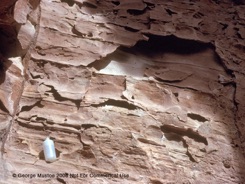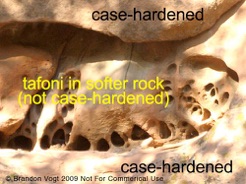Weathering
Other Factors
Cementation. Differential cementation, also known as case hardening (Conca and Rossman, 1982), is commonly invoked as an important control of tafoni development. James Dana (1849) first documented “pockets” forming by the “intersticial movement of water redepositing hardening agents” (Turkington and Paradise, 2005, p. 231).
When solutions laden with cementing agents like silica oxide, magnesium oxide, iron oxide, and calcite precipitate onto the surface of a rock (typically matrix supported clastic rocks like sandstone) weathering effects are temporarily limited. Tafoni may form when this hardened outer layer is breached revealing a core depleted in cement and especially susceptible to weathering, a process known as core softening.

The outer surface of rock outcrops and cliff faces may form hardened crusts due to pressure and temperature differences between the atmosphere and the rock interior. Differences in environmental conditions between a rock interior and a rock exterior can cause an outward migration of mineral rich solutions, which may precipitate a casehardened surface (Grantz 1976; Martini, 1978; Winkler, 1979; Cooke, Warren, & Goudie, 1993; Mellor, Short, & Kirkby, 1997).
Case hardening
Kayenta Sandstone, Capital Reef National Park (left, photo by G. Mustoe)
Lyons Sandstone, Red Rock Canyon, Colorado Springs, CO (right, photo by B. Vogt)
Conca and Rossman (1982) identified casehardening agents and proposed a model that could lead to tafoni development as a response to formation of a casehardened layer, at the Valley of Fire State Park in Nevada. They suggest airborne particles in hot, arid deserts, as well as carbonate and kaolinite cementing agents derived from the host rock itself, are the building blocks of casehardened layers. They propose a complementary model to casehardening, termed core softening, in which a rock interior weathers differentially and erodes readily because of the process of kaolinization (Conca and Rossman, 1985).
-
•Iron Minerals. The importance of iron minerals as a cementing agent is well recognized by tafoni researchers. In some cases, a hardened outer crust about 1-30 mm thick may develop by the addition of ferruginous cement derived from surface weathering, which may be essential for tafoni to develop (Bartrum, 1936; Selby, 1979). Viles and Goudie (2004) found a thin, discolored, and cemented skin (< 1 mm thick) that contained clay minerals in addition to abundant iron, magnesium, aluminum and manganese minerals. Mustoe (1982) found a thin hardened outer casing on the surfaces of tafoni walls, a result of biotite and other iron minerals dissolving.
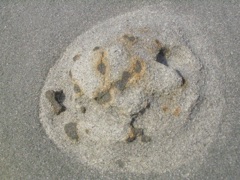
Some geoscientists emphasize the role of cement in the development of tafoni mediated by a cementing agents such as iron oxide, calcrete, or silcrete. For example, Martini, (1978) and Kejonen, Kielosto, & Lahti (1988) suggest that diagenic cement precipitated along fracture planes can shield a less resistant layer of rock and affect the distribution of tafoni forms. Smith (1978) observed a thin casehardened layer protecting the surface of limestone tafoni surfaces in Western Africa but was unsure how a protective coating could lead to tafoni formation. Yet, many rocks such as granite host tafoni but are crystalline and not clastic or matrix supported. For example, Mottershead and Pye, (1994) and Dragovich (1969) did not identify evidence to support the idea that a casehardened layer is an essential or even an important formative factor for tafoni growth in igneous or metamorphic rocks.
Lithologic Factors. Lithologic factors including porosity, permeability, conductivity, feldspar concentration, bedding, jointing, fracturing, grain size, and grain sorting may function as guides, augmenting tafoni development. Pye and Mottershead (1995) emphasized the importance of openings in the rock surface, which “facilitate the ingress and retention of saline fluids”. Mottershead et al., (2003) found that pitting occurs along bedding planes. Matsukura and Matsouka (1996) found that a large proportion of micropores in rocks relates to a more rapid pace of tafoni growth. Mustoe (1971) and Sunamura (1996) reported that tafoni are greatly controlled by the presence of weak bedding planes, fractures, and jointing, especially when such heterogeneities are located on cliff faces.

Field observations made along coastal areas of Northern California suggest that tafoni form well in areas of high permeability like along joints, fractures, and bedding planes, as well as around the rims of in situ concretions; yet, to the naked eye tafoni commonly appear randomly distributed and abundant in areas with no apparent variation in porosity or permeability. Notice in the picture below that cavities and walls may emerge from the rock itself bypassing initial pitting stages. Time elapsed pictures of tafoni show walls emerging from the rock on the Time-Series page.
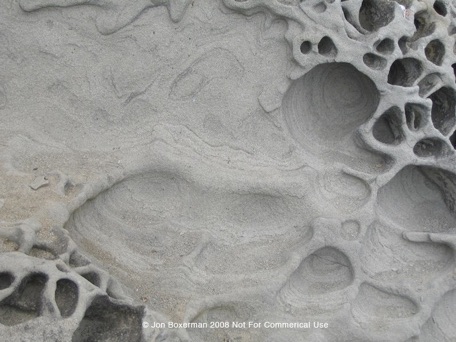
Secondary Factors. Tafoni do not appear indicative of any single weathering mechanism; rather, a confluence of processes and geographic and environmental factors work in concert (Viles, 2001).
-
•Secondary geographic factors include rock outcrop or cliff face slope, aspect, orientation, and elevation above MSL. Mottershead (1994) found that elevation above MSL, distance from mean high water mark, and the orientation of the rock relative to prevailing wind direction are significant controls on the development of tafoni. Sancho and Benito (1990) and Mottershead (1994) found that aspect of the outcrop is also a significant control on whether or not tafoni will develop. One interesting conclusion drawn by Prebble (1967) in Antarctica is that a striking positive spatial relationship exists between elevation, proximity to the coast, and the presence of tafoni. Cailleux and Calkin (1963), on the other hand, found that prevailing wind direction is not a significant factor in the formation of tafoni in Antarctica.
-
•Secondary environmental factors may include the availability and flow direction of groundwater, prevailing wind and sea spray direction, activity of small animals (e.g., lizards, rodents, crabs) and humans, the proximity to significant bodies of water like oceans or lakes, and the frequency of freeze-thaw cycles. At the Valley of Fire State Park, in Nevada, tafoni development may proceed by groundwater sapping (Turkington, 1998). Coastal tafoni in Antarctica are abundant where salt supply is plentiful, frost action is weak, and humidity is low, and the tafoni gradually disappear with higher elevation where supply of sea salt diminishes and humidity and frost action increase (Prebble, 1967). Sancho and Benito (1990) performed a statistical study of about a dozen factors influencing tafoni growth on sandstone in central Spain. They concluded that a positive relationship exists between the frequency of tafoni and geographic and lithologic factors. In particular, they found that rock slope, electrical conductivity, and concentrations of feldspars and clay minerals are positively correlated with the number of tafoni per surface area.
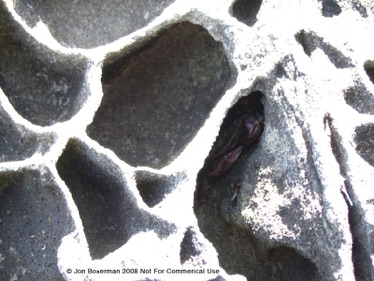
A burrowing crab, Bean Hollow State Beach
